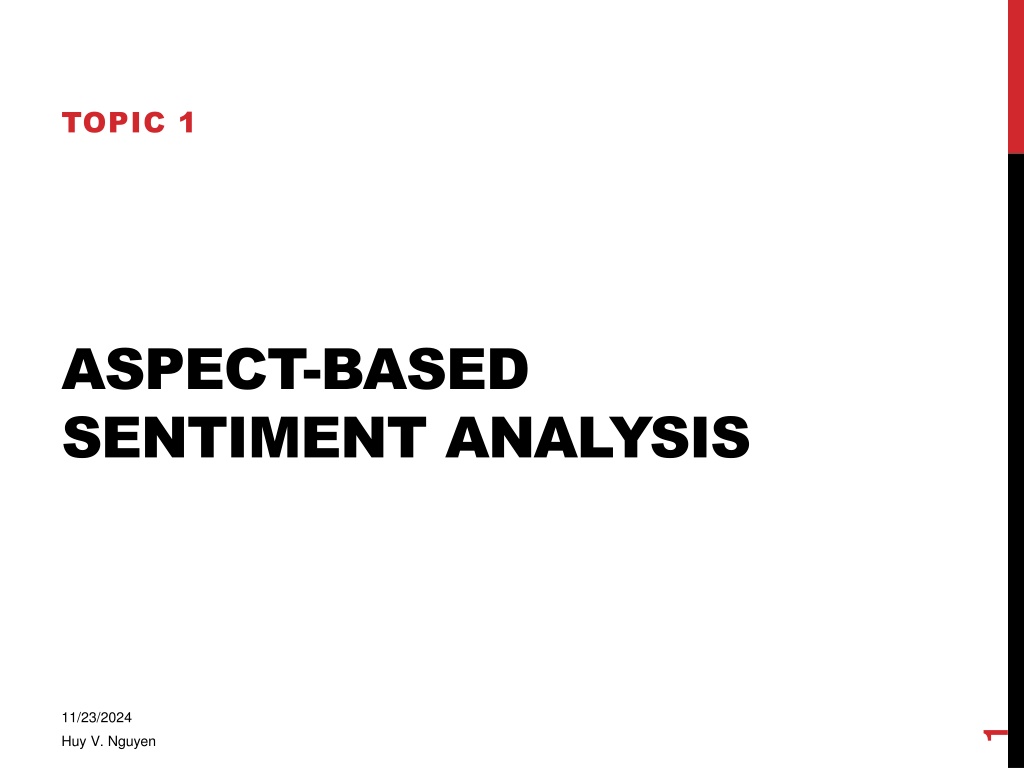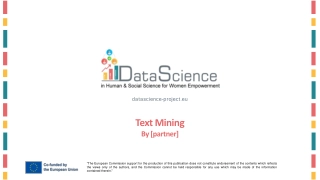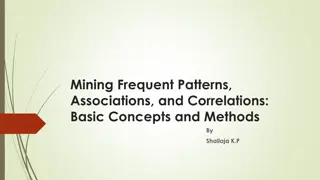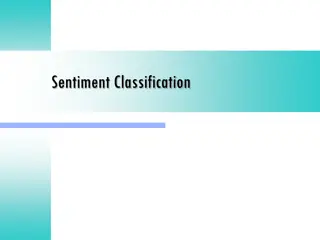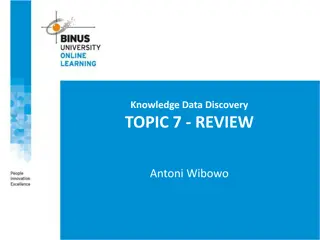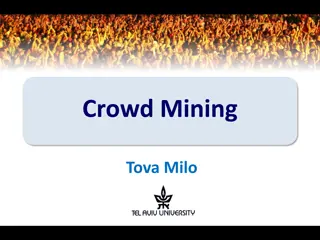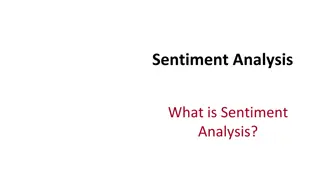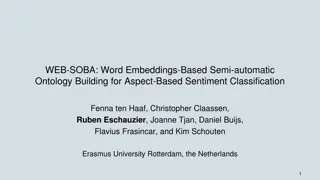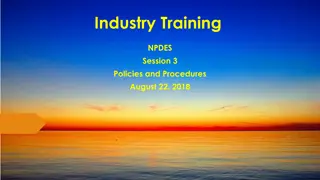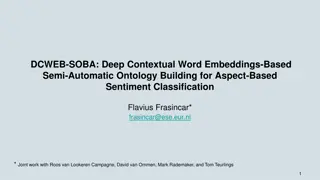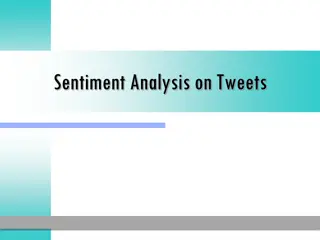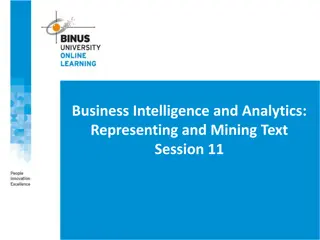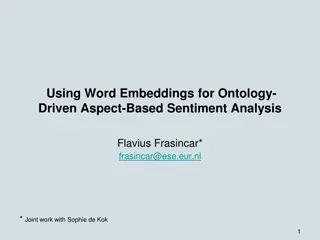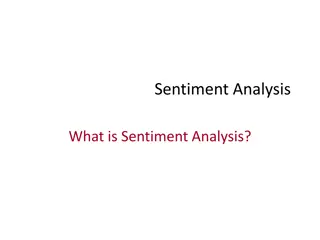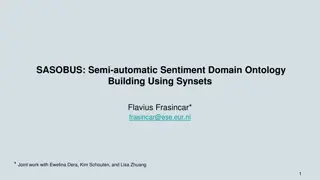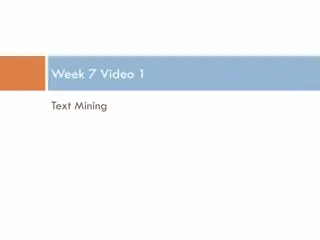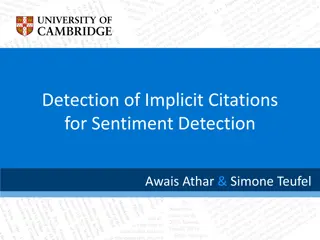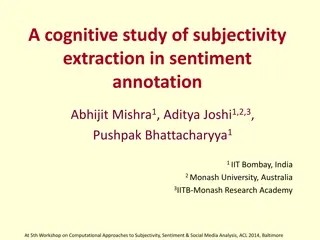Understanding Aspect-Based Sentiment Analysis in Text Mining
Aspect-Based Sentiment Analysis plays a crucial role in extracting, identifying, and characterizing sentiment content within text data. This analysis helps in understanding how people perceive various aspects in reviews, blogs, and online discussions. The process involves detecting entities, aspects, sentiments, holders, and time indicators. Aspect-based sentiment analysis is essential for businesses, researchers, governments, and individuals seeking to gain insights from textual data.
Download Presentation

Please find below an Image/Link to download the presentation.
The content on the website is provided AS IS for your information and personal use only. It may not be sold, licensed, or shared on other websites without obtaining consent from the author. Download presentation by click this link. If you encounter any issues during the download, it is possible that the publisher has removed the file from their server.
E N D
Presentation Transcript
TOPIC 1 ASPECT-BASED SENTIMENT ANALYSIS 11/23/2024 1 Huy V. Nguyen
OUTLINE Sentiment analysis problem Aspect-based sentiment analysis Data The dominance of online reviews Computational models Two-stage approaches Joint topic-sentiment models Evaluation Achievements and Challenges 11/23/2024 2 Huy V. Nguyen
WHY SENTIMENT ANALYSIS Customers: need peer opinions to make purchase decisions Business providers: need customers opinions to improve product need to track opinions to make marketing decisions Social researchers: want to know people s reactions about social events Government: wants to know people s reactions to a new policy Psychology, education, etc. 11/23/2024 3 Huy V. Nguyen
SENTIMENT ANALYSIS PROBLEM (Sentiment Analysis and Opinion Mining book, Liu 2012) Definition: given an opinion text, discover all opinion quintuples <entity, aspect, sentiment, holder, time> Tasks: extract, identify, or otherwise characterize the sentiment content of a text unit Not all elements (of the quintuple) are (necessarily) addressed at all levels of granularity Document/sentence: sentiment classification Word: sentiment lexicon generation 11/23/2024 4 Huy V. Nguyen
ASPECT-BASED SENTIMENT ANALYSIS (Liu 2012) The (almost) complete variant of the problem (Actually) discovers how people think about what Two tasks studied extensively: Aspect extraction Aspect sentiment classification Particular genres make the other tasks (more) easy Reviews v. blogs/discussions 11/23/2024 5 Huy V. Nguyen
DATA News articles Blogs Online reviews Hotel/restaurant reviews Amazon product reviews Ebay seller reviews IMDB reviews Online reviews have been studied extensively Limited amount of work on new articles 11/23/2024 6 Huy V. Nguyen
(2) ADVANTAGES OF REVIEWS Product and service reviews Known entity, opinion holder, time Metadata Well categorized/defined aspects Product specifications, service standards Highly focused and opinion rich Little irrelevant information Reduce computational difficulty 11/23/2024 7 Huy V. Nguyen
(3) DIFFICULTIES OF NEWS ARTICLES Identifies the targets Aspect may not be a proper term Good/bad news content v. good/bad expressed sentiment Different views: author, reader, and opinion holder Little amount of work has been done in this genre 8
COMPUTATIONAL MODELS Two-stage approaches Aspect extraction Aspect sentiment classification Jointly modeling aspects and opinions Inherent relationship between sentiments/opinions and their targets (aspects/topics) How much simultaneously is called jointly Double propagation is not jointly 11/23/2024 9 Huy V. Nguyen
TWO-STAGE APPROACHES Aspect extraction Frequent item mining (Hu & Liu 2004, Popescu & Etzioni 2005) In relation with opinions (Zhuang et al. 2006, Wu et al. 2009, Qiu et al. 2009) Topic models (Brody & Elhadad 2010) Aspect sentiment classification Lexicon-based starting Sentiment propagation Contextual polarity 10
(2) PROS AND CONS Rule-based approaches work well Simple sentence structure (concise writing) Sentiment and features expressed clearly (strong opinions) Shallow syntactic parsing (less prone to writing errors) Sentiment lexicon helps as a good start, but contextual polarity needs to be addressed Rule-based (Ding et al. 2008) Relaxation labeling (Popescu & Etzioni 2005) Rule-based approaches were tailored for review data ? Blogs/discussions, news articles Possible solution: Topic models + sentiment models 11
JOINT TOPIC- SENTIMENT MODELS Topic sentiment mixture (Mei et al. 2007) Topic models, positive/negative sentiment models Multi-aspect sentiment model (Titov & McDonald 2008) Multi-grain LDA + aspect rating MaxEnt classifier Joint topic sentiment model (Lin & He 2009) Each document is associated with number of topic distributions (= number of sentiment labels) Hybrid joint topic sentiment model (Zhao et al. 2010) General+specific aspect/opinion models MaxEnt component to classify topic and opinion words Unified aspect sentiment model (Jo & Oh 2011) Word is generated from unified language model, has aspect and sentiment attributes 12
(2) TOPIC V. SENTIMENT Separates topic and opinion words using model priors Positive/negative sentences as training data for sentiment models (Mei et al. 2007) Subjectivity lexicons to assign sentiment label to words (Lin & He 2009), to encode asymmetric prior sentiment information (Jo & Oh 2011) Supervised models to discriminate topic and opinion words (Zhao et al. 2010) Supervision is needed to help discriminate Aspect v. sentiment Positive v. negative opinions 13
(3) MOTIVATION AND ISSUES First attempts of using topic-model Easily evaluate models output with review data Less domain specific (unsupervised) Less prone to spelling/grammatical errors Issues Not clear separation between topic words and opinion words Not easily compare to rule-based approaches (how) Not yet adapt to other domain (politics/social events) Or other different genres (news, online discussions) 14
EVALUATION Human-labeled reviews Explicit and implicit aspects Aspect-sentiment pairs Sentence opinion User-generated ratings (aspect ratings v. overall rating) Intrinsic evaluation Precision and recall of aspect extraction Aspect sentiment accuracy Aspect rating correlation with true labels (Lu et al. 2009, Wang et al. 2010) Aspect rating regression (Wang et al. 2010) 15
(2) EVALUATION Evaluates topic-sentiment models is less quantitatively Post-hoc: human-judged aspect extraction with associated opinions Mapping accuracy from sentence (local) topics to rated aspects (Titov & McDonald 2008, Brody & Elhadad 2010, Zhao et al. 2010) Document sentiment classification (Lin & He 2009, Jo & Oh 2011) Extrinsic evaluation ? Summarization 16
ACHIEVEMENTS AND CHALLENGES Aspect-sentiment summarization Opinion Observer (Liu et al. 2005) OPINE (Popescu & Etzioni 2005) Topic life cycles and sentiment dynamics (Mei et al. 2007) Predicting sale performance (Liu et al. 2007) News article challenges Not well-defined targets/aspects Diverse and sparse topics Implicit opinions Fine-grained opinion unit extraction Frequent item mining does not work, topic models either 17
CONCLUSIONS Review data has been studied extensively Rule-based approaches are simple but perform well Topic-sentiment models are proven promising News articles are challenging 18
